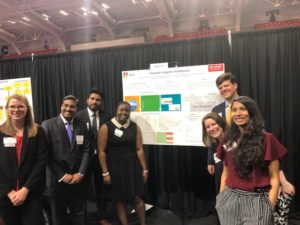Closing the Gap Between Buyers and Sellers: “Everything is Changed, Nothing is Different”
We hosted an extremely successful set of speakers at our SCRC meeting this past week. One of my core beliefs, that I’ve espoused over the 30 years that I’ve been working in this field, is that working together for mutually beneficial outcomes tends to result in better outcomes for everybody. This is perhaps too simplistic, but it’s been also proven mathematically and observed as something that happens in the evolution of mankind, specifically through the principle of the Nash equilibrium, or the prisoner’s dilemma.
Game theorists use the Nash equilibrium concept to analyze the outcome of the strategic interaction of several decision makers. In other words, it provides a way of predicting what will happen if several people or several institutions are making decisions at the same time, and if the outcome for each of them depends on the decisions of the others. The simple insight underlying John Nash’s idea is that one cannot predict the result of the choices of multiple decision makers if one analyzes those decisions in isolation. Instead, one must ask what each player would do, taking into account the decision-making of the others. each player is assumed to know the equilibrium strategies of the other players, and no player has anything to gain by changing only their own strategy
In effect, this suggests that we need to work together, and by understanding one another more, we can reach an optimal outcome. This was the theme of the SCRC meeting this past week, where we heard from both buy-side and sell-side subject matter experts, who all came together to espouse these themes.
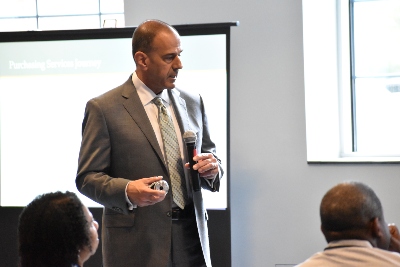
We first heard from Dan Mahlebashian, Global Executive Director, from General Motors Corp. Dan spoke about the aspirations of GM to move towards “Zero crashes, Aero emissions, and Zero congestions” – an objective that is powerful, purposeful and aspirational which we can start to feel and touch as we see autonomous vehicles and school campuses using such vehicles. He noted that reaching such aspirations isn’t possible without supplier innovation. He emphasized that in transforming GM, “We started by talking about levers that you could pull that could free up capacity in the organization, including supplier relationship management. These are the conversations I had with Steve Kiefer, the CPO. I sold him on the idea that our organization is busy fully consumed with processing transactions and measuring savings, the day to day that doesn’t allow us to get to the strategic components of supplier relationship management. We need to free up the back office to allow people to focus on the more important stuff, including Innovation around digitalizing our processes and improving products for our customer’s benefit.”
He also discussed the Working Relationship Index developed by Planning Perspectives, which shows the improvement that GM has made with its suppliers in terms of relationships. Dan noted that “GM was in last place in 2016-2017, and we were dead last in terms of how well we were to work with. In this situation, we could not be competitive. The benefits of relationships is better quality, innovation, A-team resources – it is not just about futuristic stuff. If you have a bad relationship, and people are striving for capacity coming out of recession in 2008 and 2009 who will get the capacity – the customer of choice or the jerk. You’ve got to work this. You will always be able to make up for a bad contract with a great supplier relationship however you will never be able to make up for a bad supplier relationship with a good contract – place your bets accordingly.”
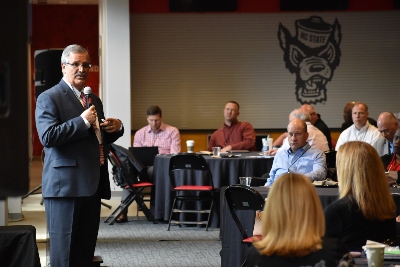
Next we heard from Bill Knittle, Chief Supply Chain Officer from Cheniere Energy. Bill has expanded the maturity of procurement contracts and relationships with suppliers over time, and has been a big believer in improved supplier relationships over his entire career . He notes that “You can lose up to 60% of your cost savings your first year, if you aren’t managing the contract actively. We have had a 20-80% loss in one year from savings. There are two levels where you can receive value: performance management, and relationship management, which is a function of the level you invest in those types of suppliers. To get the right relationships, you have to manage all contracts with some level of operational process improvement. You will get 2.5 to 3% savings if you manage it over the life of the contract, and identify opportunities for improvement. The other value is where you pick a subset of suppliers – and go after an aggressive of more than 5% of your supply base for strong relationships management. But you have to pick carefully – you don’t have the manpower of your executives to do more than this!
Bill also noted the importance of regular communication and Quarterly Business Reviews as instrumental to drive improvement, as this helps to establish value objectives, and improve clarity on where we are going with this relationship? “Quarterly meetings must include heads of sales, operations, and delivery divisions, It’s all about having the right people in the room from your side of the business that determines if the relationship is effective or not!”
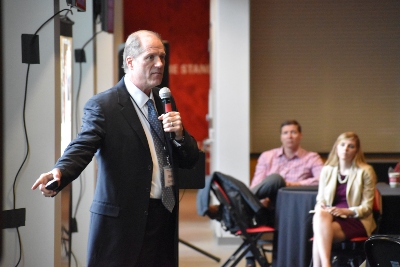
Next, Mike Boman, Vice President of Sales from UPS spoke, sharing his experiences working for 30 years in a business development role at different organizations, the last ten with UPS. Mike understands the importance of sales being able to deliver value, and of udnerstanding the customer’s core business needs, and making the procurement manager successful, including helping him/her to get a promotion based on the supplier’s performance! He emphasized that “Sales can’t just ‘show up and throw up’, and show you whatever they have in their catalogue. They need to spend the time listening to the customer, and asking the right questions to understand their business issues, and how you can help them! For example, of top importance to the CEO is top line growth, entrance to markets, and understanding how to compete in this economy. You need to then understand how the purchasing need and selling application address those needs? Does the solution create revenue? Does the solution improve the cash conversion cycle? We need to define the value of a given solution in the CUSTOMER’s terms. The right solution must consider the impact to the overall objectives of the company. If you address that, then the sales targets you have will follow!”
Mike then followed up with some exceptional case study examples. He gave one example that involved a customer where UPS had ZERO existing business, and came to operate their entire global network over time. This occurred because of the savings UPS generated for the customer. “We saved 50% of their logistics spend – and none of it came out of logistics or from my price. We were able to look at it from a more composite perspective. The purchasing guy was my biggest advocate –and he helped me to coordinate this – and we baselined the performance and the baseline spend. You have to measure the performance of the operation. This company now has $4B in sales, moving up from 1.9B!
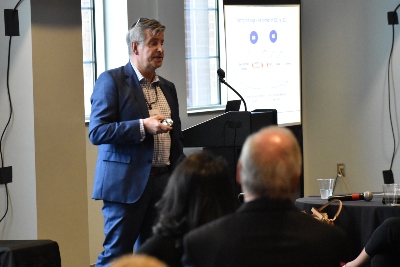
We concluded the day with discussions by Jurgen Scherer, who shared his experiences on how sales has to focus on the key accounts that matter, and that it is important to be able to be transparent about this with key customers. These portfolios can change over time, but it is critical to be open about how this state can change. Finally, we held a panel discussion with Peggy Chang Barber CEO-Americas, IACCM, Professor David Henard from NC State who teaches personal selling, Mike Boman from UPS, and Dan Mahlebashian. These individuals traded insights on this topic, which very much emphasized the points from others during the day.
Jurgen concluded with a statement quoted from Scott Stratten, the author of UnMarketing and well-known keynote speaker: “People do business with people, they know, they like, they trust.” If you believe that business is built on relationships, make building them your business if you are in sales or in purchasing. We are in the age of disruption, and we have to stop running down the streets chasing after these business squirrels and realize that business is still about great service, great products, which will make a great business. “Everything is changed, nothing is different.”
I will be putting together a white paper on this subject with Jurgen based on these insights, which we believe can help draw out these themes further. Thanks to everyone who participated, and congratulations to our Altria student team who took second place in the MBA division of the Leadership and Innovation Forum (pictured below).
